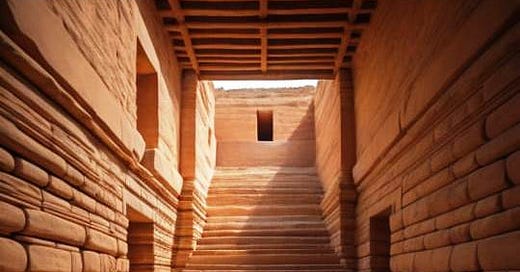"Harappa: The Enigmatic Marvel of Ancient India"
"Unearth the Secrets of Harappa: An In-Depth Exploration of the Indus Valley Civilization's Enigmatic Lost City - Ancient Wonders"
Welcome to "Ancient Wonders," your gateway to the mysteries of the past. In this edition, we embark on a journey through time to explore the enigmatic civilization of Harappa.
Nestled along the banks of the Indus River in what is now modern-day Pakistan, Harappa was one of the world's earliest urban centers and a testament to the ingenuity of our ancestors. Join us as we unearth the secrets of this lost city, piecing together its rise, fall, and enduring legacy.
The Origins of Harappa
Harappa, along with its sister city, Mohenjo-Daro, was part of the Indus Valley Civilization, also known as the Harappan Civilization, which thrived from around 3300 BCE to 1300 BCE.
These ancient cities predate the pyramids of Egypt and the Mesopotamian civilizations, making them some of the oldest urban centers in the world.
The origin of the Harappan civilization remains shrouded in mystery, with scholars speculating about the possible migration of people from the west, fertile river valleys, or indigenous development.
City Planning and Architecture
One of the most remarkable aspects of Harappa was its advanced city planning and architecture. The city was meticulously laid out on a grid system, with well-organized streets and drainage systems.
The buildings, made primarily of baked bricks, displayed a level of sophistication that was unparalleled for its time.
The city's careful design and infrastructure suggest a highly centralized authority and a society capable of complex planning.
The Great Bath
Among the architectural marvels of Harappa, the Great Bath stands out as a testament to the civilization's advanced engineering skills.
This large, rectangular tank made of finely cut bricks is believed to have served a ceremonial or religious purpose.
The fact that it was watertight and included a complex system for filling and draining the pool showcases the Harappans' mastery of hydraulic engineering.
Trade and Economy
Harappa's strategic location along the Indus River facilitated extensive trade networks, connecting it with regions as far-flung as Mesopotamia and the Arabian Peninsula.
Archaeological evidence reveals seals, pottery, and artifacts that indicate a thriving trade in materials such as copper, gold, and semi-precious stones.
The seals, inscribed with a script that remains undeciphered to this day, were used for trade and administrative purposes, shedding light on the complexity of Harappan society.
Social Organization
The Harappan society is believed to have been hierarchically structured, with evidence suggesting a ruling elite class and a labor force that likely consisted of skilled artisans, laborers, and farmers.
The presence of granaries hints at centralized agricultural practices, while the uniformity of weights and measures suggests a standardized system of trade and commerce.
It is clear that Harappa was not just a collection of haphazard settlements but a well-organized and stratified civilization.
The Decline of Harappa
The decline of Harappa, like its origins, remains an enduring mystery. Several theories have been proposed, including environmental factors such as changes in the course of the Indus River, earthquakes, or a decline in trade networks.
Another theory posits internal factors such as social unrest or the exhaustion of resources. The truth likely lies in a combination of these factors, but the lack of conclusive evidence leaves us with more questions than answers.
Legacy and Rediscovery
After its mysterious decline, Harappa lay buried and forgotten for millennia, its existence known only through ancient texts and legends.
It was only in the 19th century that the city was rediscovered by British archaeologists, sparking global interest in the enigmatic Indus Valley Civilization.
Excavations at Harappa and Mohenjo-Daro have continued for over a century, slowly unraveling the secrets of these ancient cities.
Challenges of Deciphering the Script
One of the most significant challenges in understanding Harappa is the enigmatic script found on seals and artifacts.
Despite numerous attempts, researchers have yet to decipher this script, hindering our ability to access the written records of the civilization.
The script's undeciphered nature remains one of the most frustrating aspects of Harappa's legacy, as it could potentially hold the key to understanding their culture, language, and history.
Conclusion
Harappa, the lost city along the Indus River, stands as a testament to the ingenuity of our ancient ancestors.
Its remarkable city planning, advanced architecture, and thriving trade networks are a testament to the sophistication of the Harappan civilization. Yet, its mysterious origins, abrupt decline, and undeciphered script continue to captivate scholars and enthusiasts alike.
As we explore the remnants of Harappa and other ancient wonders, we are reminded of the enduring curiosity and resilience of humanity.
The more we unearth, the more questions we uncover, but it is through these questions that we continue to learn and appreciate the rich tapestry of human history. Join us in our quest to unravel the mysteries of the past, one ancient wonder at a time.




